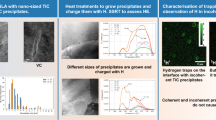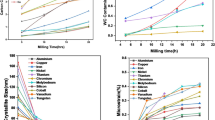Abstract
Oxidation of aluminum powders is known to include several stages, corresponding to growth of different polymorphs of alumina. The initial oxide layer is amorphous, which transfers to γ-Al2O3 at elevated temperatures and greater oxide thicknesses. This work focuses on quantitative characterization of oxidation for thin initial oxide layers occurring at relatively low temperatures. The experiments include different types of thermo-gravimetric (TG) measurements with increased amounts of powder loaded for greater sensitivity. Modulated and isothermal TG measurements were found to be less useful than constant heating rate measurements. Results were processed using both, an explicit oxidation model and a model-free isoconversion method. The latter approach was more productive in identifying the activation energy of oxidation. Using the activation energy as a function of reaction progress, the pre-exponent was also determined as a function of reaction progress assuming a diffusion-limited reaction mechanism. The reaction kinetics was validated by comparison between predicted and measured oxidation rates for nanoaluminum powders reported in the literature. Finally, the oxidation model was combined with a heat transfer model to describe ignition of aluminum particles exposed to a heated oxidizing environment. A sharp increase in the ignition temperature from 850 to 2260 K is predicted as the particle size increases from 0.3 to 1.2 µm. The results are found to be sensitive to the assumed initial oxide thickness (2.5 nm); they are also somewhat affected by the value of thermal accommodation coefficient used in the heat transfer model.















Similar content being viewed by others
References
Dong H, Zhumei S. Study of the fast reaction characteristics of aluminized PETN explosive powders. Combust Flame. 1996;105:428–30.
King MK. Aluminum combustion in a solid rocket motor environment. Proc Combust Inst. 2009;32(2):2107–14.
Ba SH, Jiao QJ, Ren H. Effect of particle sizes of aluminum powder on radiation intensity of flash pyrotechnic composites. Hanneng Cailiao/Chin J Energ Mater. 2008;16:219–21.
Price EW. Combustion of aluminum in solid propellant flames. AGARD Conf Proc. 1979;14(1–14):15.
Price EW. Combustion of metallized propellants, vol. 90. New York: AIAA; 1984. p. 479–513.
Chakravarthy SR, Freeman JM, Price EW, Sigman RK. Combustion of propellants with ammonium dinitramide. Propellants Explos Pyrotech. 2004;29:220–30.
Trunov MA, Schoenitz M, Zhu X, Dreizin EL. Effect of polymorphic phase transformations in Al2O3 film on oxidation kinetics of aluminum powders. Combust Flame. 2005;140:310–8.
Trunov MA, Schoenitz M, Dreizin EL. Ignition of aluminum powders under different experimental conditions. Propellants Explos Pyrotech. 2005;30:36–43.
Eisenreich N, Fietzek H, Del Mar Juez-Lorenzo M, Kolarik V, Koleczko A, Weiser V. On the mechanism of low temperature oxidation for aluminum particles down to the nano-scale. Propellants Explos Pyrotech. 2004;29:137–45.
Park K, Lee D, Rai A, Mukherjee D, Zachariah MR. Size-resolved kinetic measurements of aluminum nanoparticle oxidation with single particle mass spectrometry. J Phys Chem B. 2005;109:7290–9.
Zhu X, Schoenitz M, Dreizin EL. Aluminum powder oxidation in Co2 and Mixed Co2/O2 environments. J Phys Chem C. 2009;113:6768–73.
Schoenitz M, Chen CM, Dreizin EL. Oxidation of aluminum particles in the presence of water. J Phys Chem B. 2009;113:5136–40.
Trunov MA, Schoenitz M, Dreizin EL. Effect of polymorphic phase transformations in alumina layer on ignition of aluminium particles. Combust Theory Model. 2006;10:603–23.
Schoenitz M, Patel B, Agboh O, Dreizin EL. Oxidation of aluminum powders at high heating rates. Thermochim Acta. 2010;507–508:115–22.
Zhang S, Dreizin EL. Reaction interface for heterogeneous oxidation of aluminum powders. J Phys Chem C. 2013;117:14025–31.
Saif MTA, Zhang S, Haque A, Hsia KJ. Effect of native Al2O3 on the elastic response of nanoscale Al films. Acta Mater. 2002;50:2779–86.
Jeurgens LPH, Sloof WG, Tichelaar FD, Mittemeijer EJ. Structure and morphology of aluminium-oxide films formed by thermal oxidation of aluminium. Thin Solid Films. 2002;418:89–101.
Ramaswamy AL, Kaste P. A “nanovision” of the physiochemical phenomena occurring in nanoparticles of aluminum. J Energ Mater. 2005;23:1–25.
Vyazovkin S, Burnham AK, Criado JM, Pérez-Maqueda LA, Popescu C, Sbirrazzuoli N. Ictac kinetics committee recommendations for performing kinetic computations on thermal analysis data. Thermochim Acta. 2011;520:1–19.
Vyazovkin S. Modification of the integral isoconversional method to account for variation in the activation energy. J Comput Chem. 2001;22:178–83.
Aumann CE, Skofronick GL, Martin JA. Oxidation behavior of aluminum nanopowders. J Vac Sci Technol B. 1995;13:1178–83.
Trunov MA, Umbrajkar SM, Schoenitz M, Mang JT, Dreizin EL. Oxidation and melting of aluminum nanopowders. J Phys Chem B. 2006;110:13094–9.
Kong C, Yao Q, Yu D, Li S. Combustion characteristics of well-dispersed aluminum nanoparticle streams in post flame environment. Proc Combust Inst. 2015;35:2479–86.
Chen L, Song W, Lv J, Chen X, Xie C. Research on the methods to determine metallic aluminum content in aluminum nanoparticles. Mater Chem Phys. 2010;120:670–5.
Coulet MV, Rufino B, Esposito PH, Neisius T, Isnard O, Denoyel R. Oxidation mechanism of aluminum nanopowders. J Phys Chem C. 2015;119:25063–70.
Yao W, Guangsheng G, Fei W, Jun W. Fluidization and agglomerate structure of SiO2 nanoparticles. Powder Technol. 2002;124:152–9.
Danilenko I, Konstantinova T, Pilipenko N, Volkova G, Glasunova V. Estimation of agglomeration degree and nanoparticles shape of zirconia nanopowders. Part Part Syst Charact. 2011;28:13–8.
To D, Dave R, Yin X, Sundaresan S. Deagglomeration of nanoparticle aggregates via rapid expansion of supercritical or high-pressure suspensions. AIChE J. 2009;55:2807–26.
Liu X, Zhang Q. Influence of turbulent flow on the explosion parameters of micro- and nano-aluminum powder–air mixtures. J Hazard Mater. 2015;299:603–17.
Wang H, Zachariah MR, Xie L, Rao G. Ignition and combustion characterization of nano-Al–Ap and nano-Al–CuO–Ap micro-sized composites produced by electrospray technique. Energy Procedia. 2015;66:109–12.
Staiger M, Bowen P, Ketterer J, Bohonek J. Particle size distribution measurement and assessment of agglomeration of commercial nanosized ceramic particles. J Dispers Sci Technol. 2002;23:619–30.
Mohan S, Trunov MA, Dreizin EL. Heating and ignition of metal particles in the transition heat transfer regime. J Heat Transf. 2008;130:104505/1–5.
Liu F, Daun KJ, Snelling DR, Smallwood GJ. Heat conduction from a spherical nano-particle: status of modeling heat conduction in laser-induced incandescence. Appl Phys B. 2006;83:355–82.
Bazyn T, Lynch P, Krier H, Glumac N. Combustion Measurements of fuel-rich aluminum and molybdenum oxide nanocomposite mixtures. Propellants Explos Pyrotech. 2010;35:93–99.
Allen D, Krier H, Glumac N. Heat transfer effects in nano-aluminum combustion at high temperatures. Combust Flame. 2014;161:295–302.
Altman IS, Lee D, Song J, Choi M. Experimental estimate of energy accommodation coefficient at high temperatures. Phys Rev E Stat Nonlin Soft Matter Phys. 2001;64:052202/1–4.
Acknowledgements
This work was supported by Defense Threat Reduction Agency.
Author information
Authors and Affiliations
Corresponding author
Electronic supplementary material
Below is the link to the electronic supplementary material.
Rights and permissions
About this article
Cite this article
Nie, H., Schoenitz, M. & Dreizin, E.L. Initial stages of oxidation of aluminum powder in oxygen. J Therm Anal Calorim 125, 129–141 (2016). https://doi.org/10.1007/s10973-016-5369-y
Received:
Accepted:
Published:
Issue Date:
DOI: https://doi.org/10.1007/s10973-016-5369-y




